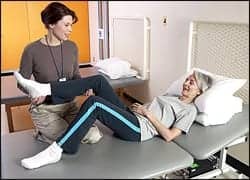
Developed by inventors at the University of Michigan, this device measures reaction times much like a drop-ruler test. (Photo courtesy of University of Michigan Health System.
Among geriatric patients, fall recovery requires more than just lower limb strength and perception of the limb’s position. It also requires complex and simple reaction times.
James Richardson, MD, professor of physical medicine and rehabilitation at the University of Michigan Comprehensive Muskuloskeletal Center, refers to these reaction times as a person’s “brain speed.”
His research delving into “brain speed” and fall recovery is published in the American Journal of Physical Medicine & Rehabilitation.
“Our study wanted to identify relationships between complex and simple clinical measures of reaction time and indicators of balance in elderly subjects with diabetic peripheral neuropathy, nerve damage that can occur in those with diabetes,” Richardson says, in a media release from University of Michigan Health System.
“These patients fall twice as often as people their age typically do, so we wanted to examine each person’s ability to make a decision in less than half a second, or around 400 milliseconds,” he adds.
The study used a device developed at University of Michigan that, Richardson explains, “consists of a long, lightweight stick attached to a rectangular box at one end. The box serves as a finger spacer to standardize initial hand position and finger closure distance, as well as a housing for the electronic components of the device.”
Reaction-time measurement is similar to a drop-ruler test. The patient or subject sits with the forearm resting on a desk with the hand off the edge of the surface. The examiner stands and suspends the device with the box hanging between the subject’s thumb and other fingers and lets the device drop at varying intervals. The subject catches it as quickly as possible and the device provides a display of the elapsed time between drop and catch, the release explains.
In the study, Richardson and his colleagues used the device to measure reaction time latency, leg strength, and perception of motion among 42 participants—26 with diabetic neuropathy and 16 without, with an average age of 69.1 years old.
They then investigated how well these measures predicted one-legged balance time, the ability to control step width when walking on a hazardous uneven surface in the research lab and major fall-related injuries over the next 12 months.
According to the team’s findings, per the release, good complex reaction time accuracy and quick simple reaction time were strongly associated with a longer one-legged balance time, and were the only predictors of good control of step width on the uneven surface. In addition, measures of leg strength and motion perception had no influence on step width control on the hazardous surface and did not appear to predict major injury.
“Essentially we found that those who were able to grab the device quickly, or quickly make the decision to let it drop, had quick brains that were somehow helping them stay balanced and avoid aberrant steps on the uneven surface,” Richardson states.
“The faster your brain can oscillate between various external stimuli, or events, and your own internal thinking clutter, the better off you are. When an elderly person falls, it seems likely that their brain is not keeping up with what is happening and so it is not able to quickly, and selectively, attend to a particular stimulus, such as hitting a curb,” he adds.
[Source(s): University of Michigan Health System, Science Daily]




